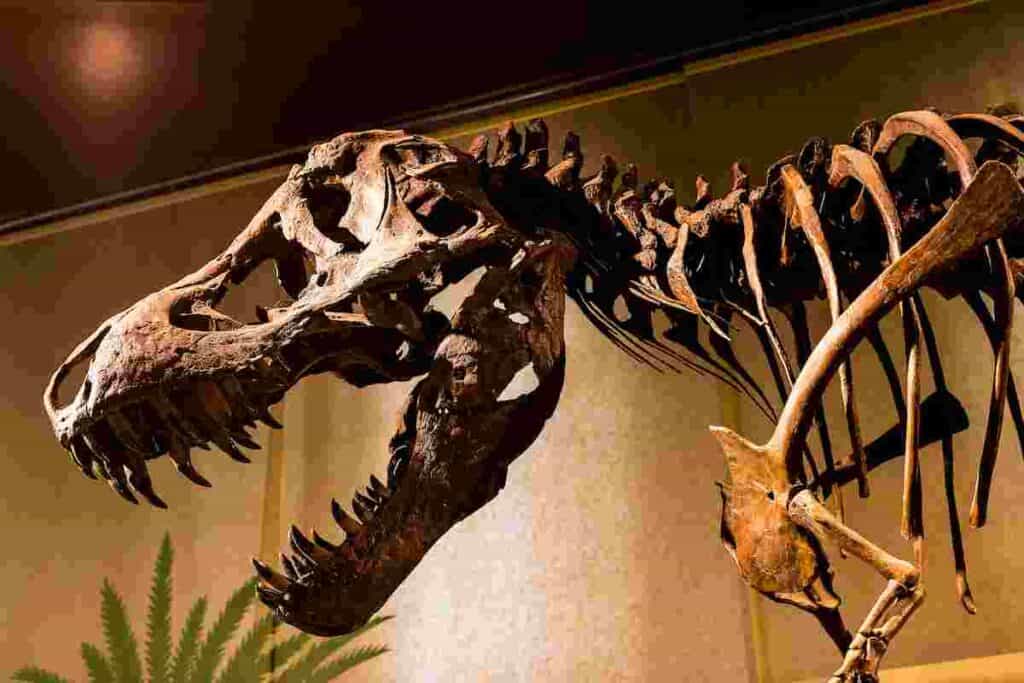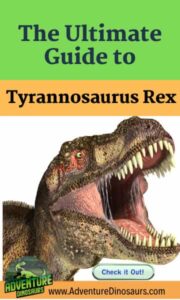When you were just a kid, you probably imagined the Tyrannosaurus Rex or T-Rex as a humongous and vicious killer terrorizing and feeding on the herbivorous dinosaurs that you saw in movies, pictures, and toys. That you are correct, but the T-Rex is not alone in the top predator tier-list back in the age of dinosaurs. The T-Rex had cousins who all were big, voracious, and equipped with rows of teeth, and they are all part of the Tyrannosaurid superfamily!

What Are The Characteristics of The Tyrannosaur Family?
What are the characteristics of the Tyrannosaur family? The tyrannosaurids were big, bipedal, carnivorous, terrestrial, and equipped with small arms and massive legs. These theropods are the apex predators of the cretaceous period.
Now that you are introduced to the whole family of apex predators, it is time to learn more about the specific characteristics that make the Tyrannosaurids infamous.
Aside from that, it is high time we share the spotlight with the relatives of the mighty T-Rex and show the unique characteristics of each species. Lastly, you are not probably expecting Tyrannosaurid fossils in Asia!
Table of Contents
How Many Species Of Tyrannosaurs Were There?
There are currently nine (9) discovered genera belonging to the Tyrannosaur family. In each of these genera, there are at least one discovered “type species.”
So you could say that during the Cretaceous period, when dinosaurs are all too familiar with lived, there are at least nine (9) Tyrannosaurus species, including the famous T-rex or Tyrannosaurus Rex.
The Tyrannosaurs are only found in North America and Asia because these lands used to be connected during the tail end of the Mesozoic Era, precisely the late Cretaceous Period.
This previously connected land is what we call Laurasia, as opposed to the massive continent Gondwana, which had no Tyrannosaurs.
In Laurasia, the dominant predators were the members of the Tyrannosaur family. Excavation sites for these flesh-eating theropods were found in states like Montana (the Two Medicine Formation), South Utah (Kaiparowits Formation), New Mexico (Kirtland Formation) and even up north in Alaska (Kikak-Tegoseak Quarry).
When these mighty hunters were around, they mostly fed and preyed upon herbivorous dinosaurs. The prevalent herbivorous dinosaurs in Laurasia during the Late Cretaceous Period were the duck-billed Hadrosaurs, Horn-faced Ceratops, and the Iguanodons.
What Makes A Tyrannosaur A Tyrannosaur
All members of the Tyrannosaurid Superfamily are strict carnivores, meaning they only eat meat which they mostly get from herbivorous dinosaurs. I mentioned “mostly” because recent discoveries and excavations led some paleontologists to theorize that Tyrannosaurs may have also engaged in cannibalism.
Aside from their nature of sitting above the food chain as apex predators, all members of the Tyrannosaur family had similar characteristics.
Features such as two sharp and long claws mounted on hilariously small arms, large skulls that accommodate their renowned biting prowess, surprising intelligence, and intuition, and lastly, long, muscular, and powerful tails. Source
Tyrannosaurs Had Sharp Claws But Short Arms
I get it; you saw, laughed, and felt sad looking at the memes people make about the mighty T-rex having short arms. However, remember that these short arms had long claws useful in holding prey, like the T-Rex, and its cousins bite the living hell out of the victim.
Paleontologists had long debated on why the T-Rex and its cousins had arms disproportionate to its massive size. Some theorize that since they had the strongest bite force ever recorded, held by the T-Rex, they probably didn’t need long arms. However, the generally accepted theory is that these short arms but sharp claws were useful in holding onto the prey.
Tyrannosaurs Had Massive Skulls
The members of the Tyrannosaur family all had massive skulls, specifically in the jaw area. These massive jaws are part of what makes the T-Rex and its cousins famous because they allow the Tyrannosaurs to have the strongest bite force the world has ever seen.
It is estimated that the T-Rex had a bite force of around 12,000 psi (pounds per square inch). For context, the saltwater crocodile, which can crush human skulls like marshmallows, had a bite force of 5,000 psi.
Tyrannosaurs Were Intelligent
Now, don’t get it confused; the T-Rex and its cousins are massive, scary, vicious, and well-equipped as predators. But that alone doesn’t define them because they are said to be one of the most intelligent and keen dinosaurs around. Some paleontologists even say that the Tyrannosaurs got smart before they got big.
Tyrannosaurs could detect low-frequency sounds, something that aided them well in detecting prey from miles away! The Tyrannosaurs had the brawns and the brain, which allowed them to rise in the food chain during the late Cretaceous Period.
❖ Read Now! The Ultimate Guide to Tyrannosaurus Rex
The main article in the series, it is packed with information all about the King of the Dinosaurs. it provides information about the first discovery, some of the latest fossil findings, and covers the anatomy of the dinosaur. Following this, it provides a look at the classification and phylogeny. The places, where T. Rex fossils have been found are described and a few of the key fossil skeletons are described. The master article also covers:
—Interesting facts you may not know about T. Rex
—Unanswered questions about the T. Rex
—Links to the Series Articles (17 in total!) which give deeper info on the dinosaur.
Surprising Tyrannosaurids Found In The US And Asia
Now that you know that Tyrannosaurs were only found in North America and Asia, it is time to meet them one by one. These Tyrannosaurs were found in states like Utah, New Mexico, Alaska, and Asian countries like Mongolia, China, and Russia.
Dynamoterror Dynastes
This member of the Tyrannosaur family once roamed what is now New Mexico during the Late Cretaceous Period. Like the other family members, the name came from the amalgamation of the Greek word “dynamis” or power and the Latin word “terror.”
The type specimen for this 30-foot predator was excavated in the Menefee Formation located in New Mexico. However, other specimens and bone fragments were also discovered in Salt Lake City, Utah.
The Dynamoterror Dynastes is one of the oldest tyrannosaur species to be discovered. It was estimated to have lived at least 78 million years ago, which put them right in the middle of the Late Cretaceous Period.
Lythronax Argestes
This tyrannosaur is slightly smaller than the Dynamoterro Dynastes, measuring at around 26 ft. However, despite being slightly smaller, the Lythronax is older than the Dynamo mentioned above terror species. It is estimated to have lived around 80 million years ago, a full 4 million years before Dynamoterror’s appearance.
The type specimen for Lythronax was discovered in the Wahweap Formation of the Grand Staircase-Escalante Monument in Utah. This ambush predator is the most basal of all Tyrannosaur family members, meaning they are the most Tyrannosaur of all Tyrannosaurs.
Aside from being the oldest, the Lythronax had distinguishable traits that separate it from the other Tyrannosaurs. It had an S-shaped outer margin of the maxilla, not that the prey would notice it when it is being eaten alive by the Lythronax. (Source)
————————————————————————————————
Related T. Rex Articles You Might Also Be Interested In:
Would A T-Rex Really Shake The Ground?
What’s the Value of a Real Dinosaur Tooth (Single, On Jawbone)?
How Would A T-Rex Get Up After Falling?
————————————————————————————————
Tarbosaurus Bataar
Now we have arrived at the Tyrannosaurs that were closely related to our favorite, the mighty T-Rex. The Tarbosaurus Bataar was a member of the Tyrannosaur family that lived in Asia around 70 million years ago. That makes it one of the youngest members of the Tyrannosaur family to appear in the fossil records, along with the Tyrannosaurus Rex.
This tyrannosaur is a large bi-pedal predator that measured up to 39 ft long. It was so big that it only comes second to the mighty T-Rex when it comes to size. Fossil remains of this behemoth were excavated in the Mongolian Desert, with some parts also found in China and Siberia.
The excavations found near its fossil remains showed that this member of the family lived on a humid floodplain, ambushing large dinosaurs like Sorolophus and Nemegtosaurus. For context, the Hadrosaur Sorolophus measured around 30 feet and weighed 3 tonnes, while the Nemegtosaurus measured around 40 feet long.
Zhuchengtyrannus magnus
The Zhuchengtyrannus magnus is another member of the Tyrannosaur family that was closely related to the Tyrannosaurus Rex. It lived around 73 million years ago, which is close to the estimated time Tarbosaurus existed. In fact, the two genera are often called “sister taxons” because of how closely related they are.
This family member measured 36-38 ft long, which is close to the sizes of the Tarbosaurus and Tyrannosaurus Rex. Fossils were discovered in Zhucheng, China, and the fossil remains of its prey dinosaurs such as Ankylosaurus and Sinoceratops.
The Tyrannosaurus Rex
We have finally made it to the king of the Tyrannosaur family, the Tyrannosaurus Rex or T-rex. Every child and adult would at the very least know or have heard of the T-Rex. After all, it is said to be the greatest apex predator of prehistoric times because of how dominant it was during the Late Cretaceous Period.
The name Tyrannosaurus Rex emanates from the word “Rex” or “King” in Latin. Since it is the king of all Tyrannosaurs, it is expected to be the biggest and baddest of them all. The T-rex measured more than 40 ft long and weighed as much as 9 tonnes.
The first T-Rex fossil remains ever to be found was a fossilized tooth. It was excavated way back in 1874 in the Arthur Lakes near Golden, Colorado. Partial skeletal remains were also found in Montana around 1902.
This king of monsters preyed upon all types of herbivorous and omnivorous dinosaurs. It had a wide diet of just about anything, whether it be the duck-billed hadrosaurs, the massive sauropods, or the armored ankylosaurus and ceratopsians.
Aside from being ambush predators that can run at surprisingly fast speed, some paleontologists suggested that the Tyrannosaurs may have even been pack hunters, just like modern wolves and orcas. Just imagine the terror in the eyes of a hadrosaur seeing a pack of T-Rex charging at them.
Conclusion
To wrap things up, the Tyrannosaurus Rex ruled atop a family of apex predators, but the other members are no pushovers either. The Tyrannosaur family consisted of fast bi-pedal carnivorous theropods that had surprisingly high intelligence. Truly, the top predators of the Late Cretaceous Period ruled with sharp claws and teeth, strong jaws, insurmountable strength, and a high degree of predatory skills.

